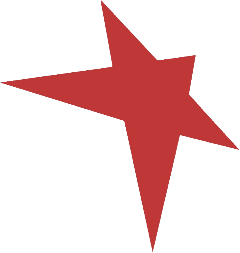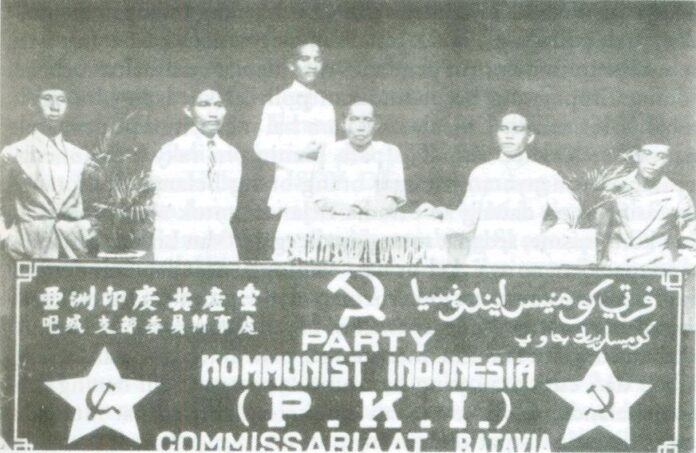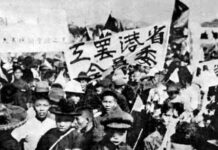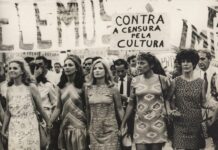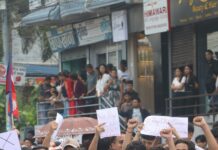US-backed coup in 1965 unleashes one of 20th Century’s biggest mass killings
Vincent Kolo, chinaworker.info
The military crackdown against the Indonesian Communist Party (PKI) that began in October 1965 and continued throughout the following year, was one of the bloodiest massacres of the 20th century with possibly one million people killed. Even the CIA, which conspired with Indonesia’s right-wing generals to orchestrate these atrocities, later compared the massacres to the crimes of the Nazis and Stalin’s terror.
US imperialism feared the loss of Indonesia, ruled by the bourgeois nationalist president Sukarno who was supported by the PKI, from the Western capitalist sphere of influence. This was at the height of the so-called Cold War, a prolonged geopolitical and military standoff between the US-led capitalist bloc and a bloc of authoritarian Stalinist regimes, ruling over state-owned but completely bureaucratized economies. The latter were light years away from genuine socialism, but their mere existence posed a threat to capitalism and imperialism by blocking its expansion and offering hope to the working class of a non-capitalist alternative.
A CIA memorandum from 1962 shows that US president John F. Kennedy and British Prime Minister Harold Macmillan agreed to “liquidate President Sukarno, depending on the situation and available opportunities.”
Racist massacres
The CIA and US Embassy in Jakarta handed over lists with thousands of names of “communist suspects” for the Indonesian army, backed up by right-wing religious paramilitaries, to round up and execute. It was Britain, by this time under the Labour government of Harold Wilson, which pushed the Indonesian army to give its terror campaign an anti-Chinese edge, targeting the ethnic Chinese who make up four percent of Indonesia’s population.
This was based on the British colonial administration’s experience in fighting the Communist insurgency in Malaya. “One of the more successful things which the West wished on to the non-communist politicians in Indonesia was to transfer the whole idea of communism onto the Chinese minority in Indonesia. It turned it into an ethnic thing,” noted Roland Challis, a BBC correspondent at the time. Western ‘democratic’ capitalism had no qualms about whipping up racist and religious divisions in furtherance of its economic and geopolitical interests.
The killings in Indonesia took place on an almost industrial scale, with common estimates of at least 500,000 dead. Rivers and waterways were blocked as hundreds of corpses were dumped night after night. The 2012 documentary ‘The Act of Killing’ put the death toll at one million. Two-thirds of the dead were ethnic Chinese. The subsequent military regime banned the use of Chinese language signs and closed down Chinese schools.
These events marked the beginning of the end for Sukarno, who had ruled by balancing Bonapartist-style between the PKI to his left and the army and feudal-Islamic groups to his right. The PKI, the largest non-ruling Communist Party in the world with millions of members, was outlawed and around one million people were imprisoned without trial. The US State Department issued a jubilant report that the number of communists worldwide in non-Eastern bloc countries had dropped by 42 percent in one year. Sukarno would remain in office only as a figurehead for a military junta, which the following year squeezed him out altogether. This ushered in the 32-year rule of the dictator, General Suharto.
Suharto’s brutal regime was one in a chain of US-sponsored military dictatorships – including Park Chung Hee in South Korea and Chiang Kai-shek in Taiwan – designed to hold back the revolutionary wave rolling across Asia and the neo-colonial world. After the Indonesian coup, Australian Prime Minister Harold Holt said that, “with 500,000 to 1,000,000 Communist sympathisers knocked off, I think it is safe to assume a reorientation has taken place.”
Unknown chapter
Incredibly, the events of 1965-66 are largely an unknown chapter in the country’s history. For decades under Suharto’s iron heel and even after his fall the school system has run ‘brainwashing’ classes with crude anti-communist propaganda films. An opinion poll in the Jakarta Post in 2009 showed that more than half of university students “had never heard of the 1960s mass killings”.
Suharto-era laws banning communism, Marxism-Leninism, and the spreading of atheism have never been repealed. This fact did not cause the slightest inconvenience to current president Prabowo Subianto (Suharto’s former son-in-law), or to his host, when he stood on the podium at Beijing’s grand military parade as the honored guest of Xi Jinping in September 2025.
A revolutionary movement would later topple Suharto during the ‘rupiah crisis’ of 1998. This was ironically after the IMF – thrown out by Sukarno but invited back into the country by Suharto – imposed humiliating austerity policies on his government. However, the army leadership with its extensive economic interests remains a major force in Indonesian politics to the present day, as shown by Prabowo, a former special forces general accused of war crimes, capturing the presidency in 2024. Similarly, the fascistic paramilitaries that carried out most of the killings in 1965-66 under military direction, have never been investigated or punished and continue to enjoy strong ties to the political establishment.
Sukarno was a radical bourgeois nationalist leader in the mold of Egypt’s Nasser and India’s Nehru, who zigzagged on the world stage between the Western (capitalist) and Eastern (Stalinist) blocs. In his final years, Sukarno had been courted fervently by Mao’s regime in China, which had also become the main international backer of the PKI leadership.
Deepening rivalry between the Chinese and Russian Stalinist regimes gave rise to the “Sino-Soviet conflict”. This confrontation between two nominally ‘communist’ regimes, which even led to a seven-month undeclared border war in 1969, was a power struggle rooted in the conflicting national interests of the two bureaucratic dictatorships, but dressed up in the language of “true communism” (Beijing) versus “revisionism” (Moscow).
In the early 1960s, as the Cold War intensified especially in Asia, Sukarno engaged in radical anti-Westernism. This did not prevent him signing a deal with Western oil companies in 1963, ignoring demands from the PKI and nationalists for nationalisation. In a conflict over British and US plans to use newly independent Malaysia as a bridgehead for Western interests, which Sukarno correctly slammed as “neo-colonial”, he took Indonesia out of the United Nations. He also expelled the US-controlled IMF and World Bank from the country.
These measures rang alarm bells in Washington and London, yet despite this, on the ground the conditions of the Indonesian masses were deteriorating, with hyperinflation, rising unemployment and stalemate over land reform. Sukarno’s speeches were full of radical rhetoric but he did not advocate an alternative to capitalism. Partial to acronyms, he launched the concept of “NASAKOM” – a fusion of nationalism, Islam and communism. This was no more than words to appease the different social forces that he attempted to balance between.
A severe drought in 1963 led to mass starvation in Central Java. When peasants, initially supported by the PKI, began to take over the land, the army launched extensive repression. Sukarno called on the PKI leaders to drop their agitation on this issue in return for token concessions, which they did.
In his excellent short history, The Rise and Fall of the PKI, Craig Bowen explains, “The nation was heavily in debt to the world’s banks and each year the budget deficit was doubling. The value of the rupiah had sunk to a hundredth of its legal value as the result of chronic inflation – in the six years to 1965 the cost of living increased by 2,000 percent. At the same time it was reported that up to an incredible 75 percent of the state budget was being spent on the armed forces.”
The “stages” theory
Growing dissatisfaction among the masses had been reflected in a meteoric growth of the PKI, which from just 7,000 members in 1952 swelled to 3 million by 1964. The PKI was by this time the third largest communist party in the world after China’s and the Soviet Union’s. By August 1965, just weeks before the military crackdown began, 26 million were organised in PKI-led unions, youth and women’s organisations – one in six of the population! The PKI’s leader Dipa Nusantara Aidit, who was captured and shot by the army in November 1965, even boasted that the party would win 30 percent of the popular vote if elections were held, something that was entirely plausible.
But there were no elections – they had been suspended with the PKI leadership’s agreement, when Sukarno introduced what he termed “guided democracy”, in reality martial law, in 1959. In the last parliamentary elections to take place under Sukarno, in 1955, the PKI emerged as the fourth largest party with 16.4 percent of the vote.
The PKI leaders were unfortunately trapped in the Stalinist mindset of the “stages” theory, believing there was no immediate possibility of a socialist revolution in a neo-colonial country like Indonesia, only recently liberated from Dutch colonialism, and concluding that the task of the workers’ movement was to support the most radical wing of the national capitalist class in an ‘anti-imperialist alliance’. The aim, according to this schema, was to consolidate national capitalism and ‘democracy’ while postponing the idea of socialism and the working class taking power indefinitely. PKI leader Aidit insisted, “the class struggle is subordinate to the national struggle.”
This idea, an article of faith for the Stalinist communist parties, meant that the PKI leaders acted as a giant brake on the struggles of the masses. They emphasised nationalist causes such as the military and political confrontation with the US-British sponsored state formation of Malaysia (which shared a land border with Indonesia on the island of Borneo), but at the expense of engaging in struggle over class issues in the manner of the 1917 Russian Revolution and its famous slogan, “Peace, bread and land!”
Under the terms of the PKI’s alliance with Sukarno, the party became a de facto appendage of his bourgeois nationalist government, robbed of any independence in action or programme and only undertaking campaigns sanctioned by the president. “The party’s large labour, youth, and women’s organisations could produce splendid rallies for Sukarno to address; such meetings, however, could do little to persuade the rank and file in the cities and towns that the PKI itself was moving closer to power,” observed the historian David Mozingo.
Political differences between the PKI, ostensibly standing on the foundations of ‘Marxism’, and Sukarno, became blurred in the eyes of the masses and even it seems within the PKI leadership.
As Australian historian Rex Mortimer noted, “By 1963 the party’s worship was becoming almost idolatrous. Despite the President’s notorious disdain for, and ignorance of, economic affairs, it declared that the solution of economic difficulties could safely be left in his hands. A short time later (Aidit) bestowed the final accolade by describing the President as his first teacher in Marxism-Leninism.”
Re-run of 1920s China
The political confusion of the PKI leaders, their failure to comprehend and and pursue an independent, clearly socialist position appears almost as a re-run of the mistakes of Stalin and the politically inexperienced Chinese Communist Party (CCP) in China in the 1920s, which produced the catastrophic defeat of 1927, with the bloody crushing of the most advanced layers of the Chinese working class.
Leon Trotsky, whose theory of the permanent revolution is the best ever answer to the Stalinist theory of ‘stages’, explained that Marxists can and will, dependent on concrete conditions, enter into temporary alliances of a purely practical character with non-socialist and even bourgeois parties, for example to resist imperialist military intervention or in defence of democratic rights, but at the same time maintain their complete political independence and freedom of action.
This is why Trotsky opposed the entry of the CCP into the Kuomintang in 1924, a policy foisted upon the CCP by Stalin. This amounted to the party’s total subordination to the bourgeois Kuomintang – a party and a social class that was not capable of leading a bourgeois democratic revolution to victory and which would inevitably take measures against the working class.
How ironic and abhorrent that 40 years later, Mao Zedong’s Stalinist regime in China enthusiastically argued for the PKI’s subordination to Sukarno. As in the 1920s, the result was murderous counterrevolution and the annihilation of the advanced communist layer of the working class. Failing to understand the horrific defeat of the Chinese Revolution in 1927, the CCP applauded the PKI’s political subservience to Sukarno. In 1963, Aidit was made an honorary member of the Chinese Academy of Sciences and his selected works were published by the CCP. The PKI’s so-called united front with Sukarno was declared “of great international significance for the international Communist movement”.
The aim of this flattery was to prize the PKI away from Moscow and into Beijing’s orbit; to boost its standing in the world communist movement, and to use the PKI as a bargaining counter for Beijing to win influence with Sukarno and the Indonesian bourgeoisie. This replicates how Stalin four decades earlier had used a politically neutered CCP to secure an alliance with Chiang Kai-shek’s Kuomintang, in furtherance of the national foreign policy interests of Stalin’s ruling group rather than the interests of working class revolution.
Even after the military crackdown had begun in late 1965, far from calling for a ‘people’s war’ or armed struggle against the counter-revolution, the Chinese regime’s advice to the PKI was “don’t panic, don’t be provoked”, a position dictated by its hope and desire not to weaken Sukarno’s position further in order to salvage their ‘alliance’. Even this echoes Stalin’s doomed China policy and his attempt, after Chiang Kai-shek’s Shanghai massacre of 1927, to salvage an alliance with the so-called ‘left Kuomintang’ led by Wang Jingwei, rather than allow the CCP to re-orientate around a clear Marxist line.
Consequently, when the Chinese Embassy in Jakarta was attacked by racist mobs, the official Chinese response was muted. The decision by small remnants of the PKI to turn to guerrilla struggle, in reality just a faint echo of the previous mass movement, came later, in 1967, when it was also clear that the CCP regime’s policies in Indonesia had collapsed.
Cruellest of defeats
The spark for the 1965 military crackdown came when a group of radical army officers, the G30S (Gerakan 30 September), staged a botched coup on 30 September, capturing and killing six right-wing generals. This abortive action was probably launched to thwart a coup plot hatched by right-wing generals set to take place a week later. The army high command backed up by US imperialism saw their opportunity to brand the failed coup as the handiwork of the PKI and launch massive retribution.
The PKI membership was taken completely unawares by the G30S putsch; although it’s possible a section of its leadership had prior knowledge. What happened next could be summarised in one word: paralysis. Once the army launched its counter strike with devastating anti-communist propaganda, there was only one possible course of action to avert disaster: mobilising the PKI’s mass forces onto the streets and calling a general strike to prevent what was now a right-wing military takeover to crush the masses’ chances of resistance.
The PKI’s response should have demanded immediate elections, land to the peasants, a price freeze and wage increases, the nationalisation of industry under worker’s democratic control, democratic rights within the army and election of officers, and speedy formation of workers’ armed militias. Such a response had a realistic chance of success had it been done immediately, before the right-wing army leadership had consolidated its hold over the government and the country. Unfortunately, failing to see the dagger held at its throat, the PKI leaders issued no such call and placed their hopes in their “friend” Sukarno to rescue the situation.
There were similarities both with Germany in 1933 and Chile 1973, in the lack of preparedness and resulting helplessness of PKI cadres once the repressive onslaught was unleashed. PKI members, even leading members, were left without a survival plan. “Wait for instructions,” seems to have been the widely shared advice. But instructions never came.
The rout of the PKI and the bloodbath that followed is a chilling warning to the international working class not only of the readiness of the capitalists, the generals, and imperialists to engage in mass carnage to save their system, but also of how political mistakes – illusions in “radical” bourgeois politicians, lack of a clear socialist programme and blurring of the distinction between working class and capitalist politics – can be translated into the cruellest of defeats.
Indonesia on a capitalist basis has gone from crisis to crisis. Its Gini coefficient (a measure of inequality) has risen from 0.285 in 2000 to 0.375 in 2025. The country is currently being rocked by the biggest mass protests since the fall of Suharto’s dictatorship 27 years ago. Prabowo, the current president, is the political progeny of the right-wing militarists of 1965 – trained (and briefly sanctioned) by the US, with an ingrained hostility to “Western”-style democracy. As a new generation of working class fighters and socialist-influenced youth move into struggle, the lessons written in blood of the rise and fall of the PKI must be learned.
